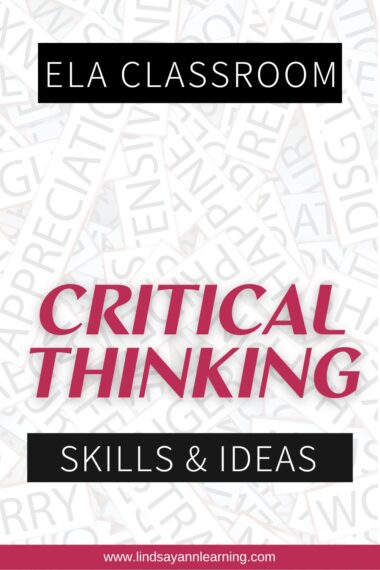When I first started teaching, we had one computer in each office and each classroom, and I remember waiting in line to use it. We scheduled time in the LRC computer labs, but this was not guaranteed. We thought nothing of it. Classroom discussion took place during class, and that was that. Sure, I found ways to make student discussion work better over the years, but there was nothing life-changing. Then, all of this new technology started to emerge, including some of my favorite online discussion tools and I was like where have you been all my life, you game-changer, you!
Best Online Discussion Tools
Let’s talk about ways to use online discussion tools to facilitate student discussion.
Remember, the goals for online discussion are still the same:
- Clear norms and expectations
- Framed and focused
- Student-led
- Rooted in text(s)
But online discussion tools make it so much easier to engage students in consistent, varied discussion both in and out of the classroom.
Free Online Discussion Tools
1. Poll Everywhere
- It is easy to create and share a quick poll with your students to frame a discussion or as a ticket in (or out) the door. This is where I began dabbling in technology-aided discussion.
- You can use this in the middle of a discussion, too! If a student asks a question that is truly worthy of a “stop and consider” moment, or if you notice the discussion getting stale, you can “spark” a new discussion by quickly posting that student’s question or asking one of your own. Stop, have students vote
, and use the results to inspire continued dialogue.
2. Today’s Meet (free), Backchannel Chat (paid)
- Opening a “back channel,” which is basically an online chat room moderated by the teacher, allows for another discussion stream in the room. I’ve used this during “fishbowl” discussions as a way for audience members to actively participate in the discussion, sharing their own ideas and questions based on what is said in the fishbowl. I’ve also used this as a way to quickly gather opinions or questions from students, as a ticket-out-the-door, and as a way for audience members to ask questions during a presentation or debate.
- Benefits of this format include engaging all students, particularly introverted students who don’t like to be in the spotlight. If using this, I would suggest keeping the discussion groups small (create multiple channels) – for it to be a true “discussion” vs. train of thought random comments, there cannot be a ton of comments clogging the feed. This is overwhelming to students.
3. Nearpod
- There are a lot of great features offered by Nearpod, which is basically like a PowerPoint…except interactive. You create the content and intersperse multiple choice and open-ended questions, as well as “draw it” opportunities and other bells and whistles and students join the presentation. Then, the magic happens: every device has the same screen as you, the teacher, and you decide when to “flip” student screens. But my favorite feature is the anonymous sharing function which allows the teacher to scroll through student responses, select ones to showcase or use to prompt further discussion, and then click a button to make them appear on all student screens.
4. Padlet
- This is an online space to which students can post ideas, thoughts, questions for discussion. It is the digital equivalent of my “graffiti wall” activity. I used to (and still sometimes do) get a large sheet of paper, cover the entire board with it, and have students fill the paper with words, images, quotes, questions, and connections. Then, students use this as a springboard for further discussion in partners, small group, and even whole class.
5. Flipgrid (is no longer available…may it rest in peace.)
- This online discussion tool allows a teacher to post a topic for discussion (could be student-generated) to a discussion “grid” which is simply an online space for collaborative thought. Students then respond to the topic by recording their thoughts in short video clips. Viola – every voice is heard! Then, students can watch the videos of their classmates and respond back to them, generating further discussion. I love that this incorporates multiple modalities, 21st century skills, as well as speaking and listening skills. I find that it’s helpful to have multiple “tricks” for discussion up my sleeve, because variety is the spice of life and student engagement. This is a great way to mix up classroom discussion of a specific text, theme, or topic. Students can share research, ask questions, and have time to think and respond in-depth too each others’ thoughts.
6. Vocaroo or Screencast-O-Matic
- Quick teaching hack! If you want a completely free version of the Flipgrid experience, here’s a workaround if you have an LMS platform such as Google Classroom, Edmodo, or even Seesaw that supports student video upload and threaded discussion.
- Have students record their thoughts in response to a prompt by creating a Vocaroo voice comment or by creating a screencast video. Your prompt could be a statement, word, question, startling statistic, text/excerpt, quotation, image, video, infographic, personal story…there are a lot of possibilities here! The mp3 or mp4 file could then be uploaded to your platform of choice where students could watch the videos and respond to each other.
- By the way, Vocaroo is a great tool for students to practice reading fluency, to record thoughts in response to a teacher-created video in a flipped classroom environment, or to record an audio version of an original piece of writing.
7. G Suite
- I’m a big fan of Alice Keeler, and she has several awesome templates which you can download for free if you want to:
- Host a “mock” Twitter chat
- Run a classroom discussion using Google Sheets (which can then be posted to Google Classroom)
- Run a classroom discussion using Google Slides
Over and out! If you find value in these posts, please share your ideas by commenting below. What online discussion tools do you use? I’d love to hear from you!



 , and use the results to inspire continued dialogue.
, and use the results to inspire continued dialogue.












 10 Student Led Discussion Strategies for Whole Class Discussion
10 Student Led Discussion Strategies for Whole Class Discussion
Very nice. Thanks..
Hi Lindsay Ann,
I’m not sure if you’re still getting emails from this site …
But if so, I’d like to ask for your suggestions/help in making some good choices for ways that our Grief Group can now continue to have helpful/inspiring meetings online during this Coronavirus challenging time.
We have each lost a loved one (most of us our spouses) to 1 of the many types of cancer.
Thanks very much for getting back to me …
And if this is the right channel to reach you on,
then I will share more about what we hope to achieve and setup for a new means of communication.
Many thanks for your reply,
Drew (S. Calif.)
Hi Drew – We are certainly having to be more creative with online meetings during this time. You might consider Zoom, Google Meet, or Google Hangouts for your online meetings. Zoom has a free version that gives 45 minutes of talk time and would be what I would recommend if everyone doesn’t have a Google account.
I hope this helps!
Lindsay